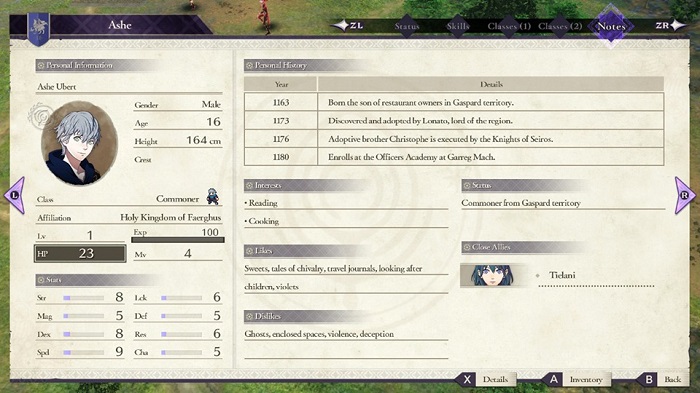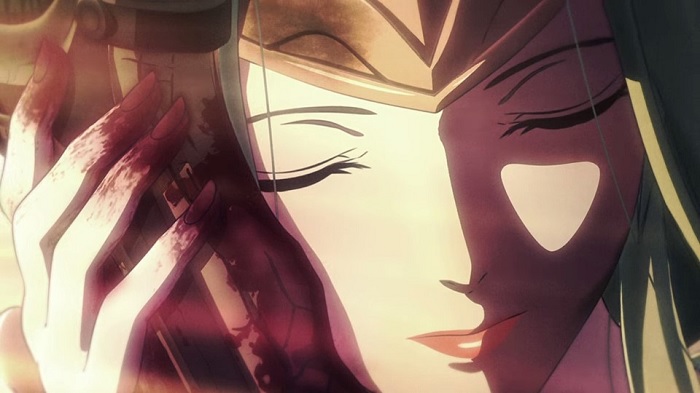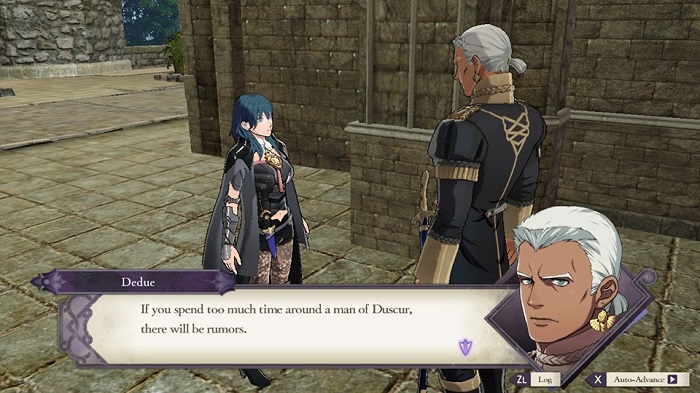Subjective:
Publisher Nintendo, alongside developers Intelligent Systems and Koei Tecmo Games, present Fire Emblem: Three Houses for review (hereafter referred to as Three Houses). Three Houses aims to update the series tactical gameplay for the Nintendo Switch by eliminating the rock / paper / scissors military battles and introducing a year-long teaching mechanic to get the player invested in the growth of their students. The player, who plays a newly appointed instructor with a mysterious military past, may guide the students to glory under one of the three factions that control most of the land. With so many strong personalities backed by different military powers under one roof, it’s only a matter of time before the powder keg of conflict between the nobility and commoners goes off.
Objective:
After a brutal opening cinematic pitting a green haired woman against a muscular darkened opponent, Three Houses jumps straight into the tactical action. The player character is a man named Byleth, though the player can choose the name or select a female lead instead. This main character primarily helps the student leaders of the three major factions, who, as stated before, control a majority of the land in the game world. Those three factions are Dimitri of the Holy Kingdom of Faerghus, Edelgard of the Adrestian Empire, and Claude of the Leicester Alliance. The action begins by fending off an assault by thieves through turn-based combat that takes place with grid movement on a map. The wave of numbers following each subsequent clash is helpfully explained by quick tutorials, allowing the player to continue to learn through experience or stopping to read the information.
The real meat of Three Houses begins shortly after the introductory battle ends. The player must choose which of the three factions they want to teach throughout the school year. This will have significant ramifications down the line and learning how to win over the different students will shape their destinies. In between major battles are school sections where the player can get individual instruction for themselves, build relationships by taking students or faculty out for meals, go fishing, answer letters, sing in choir, and more. The number of options is introduced slowly with each break in between the major battles, adding another way to get to know the people in the academy.

Assessment:
War is never good and while there are opportunities for heroics within war, the existence of war guarantees oppression and devastation. Through war Civilians are killed and someone has to decide what to do with the power following the conflict. On this note, I was not expecting Three Houses to so thoroughly embrace how awful war is. Intelligent Systems and Koei Tecmo Games show this early on with an opening cinematic that sets up a serviceable, if standard, showdown between the aforementioned stock green haired anime heroine and her dark armored opponent. Before too long the green haired heroine launches into a brutal assault, eviscerating her opponent well after their death, caressing her blood-soaked dagger as though it were a newborn object of affection. Later context does not add a noble or righteous dimension to this violence, because Three Houses goes out of its way to show how the victors shape history.
Three Houses is a direct critique of the fun – if vapid – approach to heroics of the Fire Emblem: Fates trilogy. In that trilogy, who you sided with was more a matter of aesthetics than philosophy as the “other side” always ended up being overtaken or infected by some kind of evil. It’s a clean and cowardly way of creating a war the player can take part in with a clear conscience. Three Houses is the best written Fire Emblem game in the series’ history because it thoroughly rejects that simplicity. Every character is infused with secrets, loves, and a deep history with the various struggles that have shaped the Fódlan continent it takes place on. Race, class, sex, education, religion, gender, power – all of these play a role in determining why each character fights.

Since there are over thirty different characters that you can form bonds and fight with, I’ll focus on Dedue of Dimitri’s Blue Lions. Dedue is a dark skinned Duscur, a people who were massacred by Dimitri, and has pledged an oath to protect Dimitri until such a time comes that Dedue’s people can be free once again. Nothing about their relationship made me feel at ease. Dimitri approaches Dedue’s pledge with a digital version of the White Man’s Burden, and Dedue is too aware of how much he sticks out at the elite academy that might as well be Ivy League. Additionally, Dedue himself is plagued with survivor’s guilt, and other members of Dimitri’s own house treated Dedue in a way I found unacceptable. How unacceptable? I made this person fight on their own with no help from the others since they were so sure of their superiority to Dedue.
The writing in Three Houses is so strong I indulged in my own brutal power fantasy by seeing how long a racist could stand on their own. It’s to the developer’s credit that the end of that investigation is, “Not more than one battle.” Does that make me better or worse than the character that became the target of my experiment? That’s up to you, reader, because that’s the kind of ethical consideration that Three Houses crafts and therefore this isn’t a typical review.
As the writing is much more complex, the kinetic approach to the battles is conversely more straightforward. Fire Emblem, overall, has been dawdling too much in a hyper cinematic back and forth with each attack since its first 3DS installment Awakening. Three Houses keeps a little celebratory pose but otherwise animates direct shows of power and skill with immediate results. The developers also keep things from getting too celebratory by occasionally making your enemies other children, people who are looking for food, rebels tired of the nobles pushing them around, nobles who think they can lead their people out of oppression… and on and on and on and on. It becomes quickly apparent that the show of violence in the animations grants victory not to the just but the ones who strike most viciously for their cause.

The addition of Battalions to the battles is a great thematic and interesting tactical component. Much of Three Houses is about how strength of personality and philosophy can lead others to kill, so it follows that giving the option of assigning soldiers to each character is possible. They aren’t game-breaking as they offer mild stat bonuses and limited use powers, but they can help turn the tide when power alone isn’t enough and a numbers advantage keeps the enemies from being able to counterattack. Three Houses also did well to remove the rock / paper / scissors focus in the battle system as it meant needing to keep a balance of skills with just a bit of specific fighting expertise among my characters. That meant keeping an eye on everyone, not just creating the boring situation of moving my one brute force character into action repeatedly.
Three Houses‘ final twist is a doozy with daily life at the Academy creating much of the great character interactions and insights. You don’t have to spend a lot of time there but you’re missing out on the bulk of character development if you do. Some of it works great, like the choir practice marrying religious belief with authoritarian direction (not the path I expected but it makes a scary amount of sense in practice). Other bits are so silly that I wish games, in general, would do away with them. These include the camera friendly tea time, a bit of sparkly nothing that serves to strongly bond with one character but is really out of place model appreciation, and the fishing mini-game that involves matching circles together. They make less sense as gameplay elements or bonding pieces as time goes on and detract from the otherwise excellent interactions possible with cooking (which only involves getting ingredients and having time) and conversation.

The Review
Fire Emblem: Three Houses
No other game in 2019 tries to tackle as much, and as successfully, as Three Houses. When it missteps they are in-line with standard RPG practices that developers should consider chucking as additional minigames don't always add to the experience. But Three Houses always rights itself immediately after those stumbles, presenting a myriad of complicated questions of power that have taken residence in my mind long after the battlefield fades from my screen.
PROS
- Rich history and motivations of the many characters leads to a thorough critical evaluation of the evil of war as well as Fire Emblem itself.
- Revamped combat system rewards careful consideration of skills and covered ground instead of simple strength / weakness showdowns.
- Myriad of gorgeous art styles do not shy away from the violence while showing this land struggling to craft the myth of its own struggle.
CONS
- Tone-shattering minigames that serve only to extend the play time to sparkly inconsequence.



